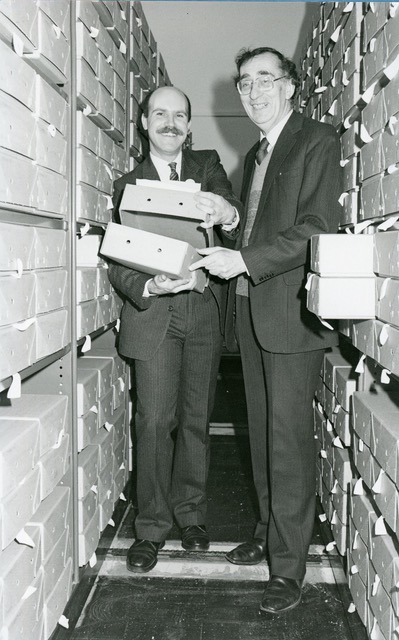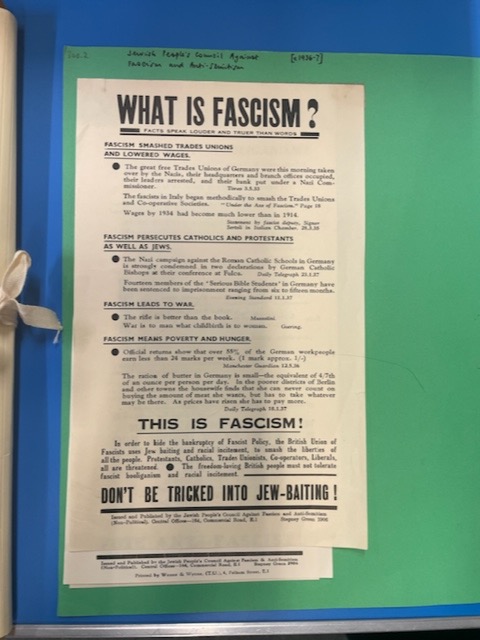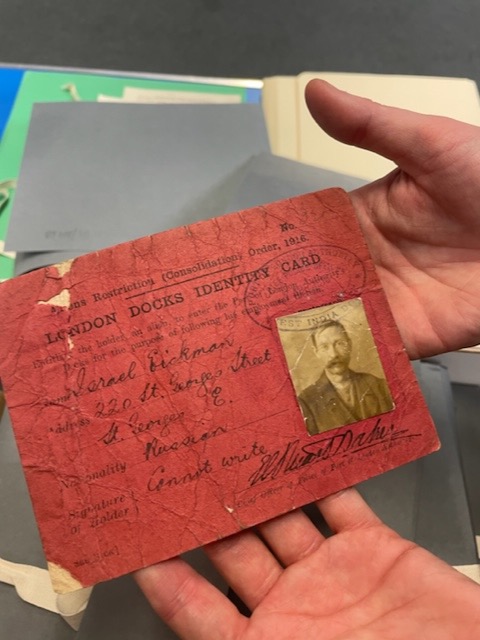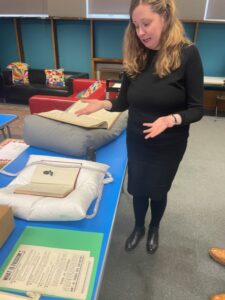Collection Encounter: Tower Hamlets Treasures
Tower Hamlets Local History Library and Archives can be found tucked away in a side street near Stepney Green tube station in London’s East End. Housed in a historic Grade II listed 19th century building, which was originally designed as the vestry hall for Mile End Old Town, it was converted into a library in 1902 and has been serving the local community and beyond ever since. The collections there include outstanding resources on the history of the area. The material dates from the 16th century to the present day and includes books, pamphlets, photographs, electoral registers, business and organisational records, local government archives, illustrations, maps, property deeds and land transactions as well as film footage and audio recordings. Because the archive is in the heart of a former Jewish quarter their collection of Jewish material is substantial and very varied.
I have visited this place countless times over the decades, whilst researching the social history of the former Jewish East End. Copies of material from this archive feature in many of my publications and projects. I was involved in a campaign to save this library from closure in 2009 and every time I have visited the historic Reading Room there since, with its ornately decorated domed plaster ceiling and purpose-built mahogany bookcases, I feel immensely grateful that this unique archive and its extraordinary collections are still accessible to researchers like me and members of the public.
I have always found the archivists there to be extremely friendly and knowledgeable and the newest edition to the team is no exception. Last week I met with Heritage Officer (Archives) Annette Mackin to explore some of the treasures from their collections that relate to Jewish life. Annette had laid out a range of materials for me to see in the large education space on the ground floor.
 The first item related directly to the story of the archive itself. It was a photograph of the historic moment when archivist Jerome Farrell and East London Jewish historian, the late Professor Bill Fishman opened the climate-controlled strongroom there in 1988. Bill had been my mentor and friend for many years. He was the person who taught me the geography and stories of the former Jewish East End, which he knew from lived experience having grown up in the area. His many acclaimed publications continue to be important texts for historians and students and his walking tours of the former Jewish East End were legendary. Annette told me Bill’s archive had recently been deposited there by his son. Whilst sorting through the boxes of as yet uncatalogued material Annette had found an original artwork about the street Brick Lane by East End artist Dan Jones, which included a picture of me holding my book On Brick Lane standing next to Bill Fishman. I will treasure this image forever!
The first item related directly to the story of the archive itself. It was a photograph of the historic moment when archivist Jerome Farrell and East London Jewish historian, the late Professor Bill Fishman opened the climate-controlled strongroom there in 1988. Bill had been my mentor and friend for many years. He was the person who taught me the geography and stories of the former Jewish East End, which he knew from lived experience having grown up in the area. His many acclaimed publications continue to be important texts for historians and students and his walking tours of the former Jewish East End were legendary. Annette told me Bill’s archive had recently been deposited there by his son. Whilst sorting through the boxes of as yet uncatalogued material Annette had found an original artwork about the street Brick Lane by East End artist Dan Jones, which included a picture of me holding my book On Brick Lane standing next to Bill Fishman. I will treasure this image forever!
‘We’re very proud that Bill opened this archive’ said Annette, as we moved over to a table nearby to look at other material. ‘The Jewish story of the area is just embedded into our collection here, we have a wide range of items’ said Annette, pointing to a book containing ‘The Worker’s Friend [Der arbayter fraynd]’ a Yiddish newspaper from 1905 to ‘06. ‘It’s just a wonderful snapshot into that early 20th century radical Jewish community that was organising for themselves and coming out of the late 19th century radicalism,’ said Annette as she turned the pages of the rebound and preserved newspapers. We were unable to read the Yiddish text but even the adverts within revealed so much about the concerns of the day, with placements for tailoring tools and adverts for steamships to New York.
The next item was a book called ‘This Whitechapel of Ours: Humorous Sketches’ (Published by London Naroditczky, 1944) by A.M. Kaiser, which was also in Yiddish. ‘I can’t access the stories within, but Vivi Lachs in her book London YiddishTown translated some of Kaiser’s sketches.’
 The next ‘treasure’ we examined was some original leaflets produced by the Jewish People’s Council Against Fascism and Antisemitism, relating to the organising of the political march, which later became known as The Battle of Cable Street on October 4th, 1936. ‘These leaflets would have been handed out to people on the streets, they describe in layperson terms what is fascism.’ I was fascinated by the line ‘Don’t be tricked into Jew baiting.’
The next ‘treasure’ we examined was some original leaflets produced by the Jewish People’s Council Against Fascism and Antisemitism, relating to the organising of the political march, which later became known as The Battle of Cable Street on October 4th, 1936. ‘These leaflets would have been handed out to people on the streets, they describe in layperson terms what is fascism.’ I was fascinated by the line ‘Don’t be tricked into Jew baiting.’
‘These leaflets are part of our library cuttings collection,’ said Annette, ‘which is a treasure trove because a lot of people think that just means newspaper cuttings, but actually you’ve got things like this important document and other historical ephemera.’ We moved on to another folder of material again related to Cable Street. Inside were transcripts of oral histories by the Cable Street Group conducted in the 1980s, including eyewitness accounts of the event by such figures as Michael Rosen’s dad, Harold Rosen.
The final items we explored were two collections of family records which had been gifted to the archive. ‘This assemblage of material is about the Veltman family of Bethnal Green, it’s priceless,’ said Annette as she unwrapped a collection of faded coloured cards from their acid free wrappings. ‘These were gifted to us by a depositor called Joseph Cohen. You could tell the whole story of the Jewish East End through the story of this family’s ephemera and records.’ She showed me trade union cards, a ration book, which listed the foods the family were buying both during and after the war in local Jewish-owned shops, other records which showed where they were living, and pre-NHS medical cards. ‘Annie and Morris Veltman were the parents of Jack and Phyllis,’ said Annette pointing to the names on the cards. ‘Phyllis and Annie were killed in the Hughes Mansion disaster, the last V2 bombing in 1945. Phyllis was only 19.’
 We moved on to examine another archive belonging to the Rosenberg family of St George in the East. ‘Israel Rosenberg was the head of the family, and was previously known as Israel Eickman/Eichman, which you can see here in his identity book’ said Annette as we looked at the document. ‘This item was issued in 1918 and tells us he was born in 1869 the son of Lazurus and Anna Eickman. His occupation was a ‘boot laster’ (for Cohen and Company of Hanbury Street). It also includes a photograph of Israel and a thumb print. Inside are stamps by the Metropolitan Police at Leman Street where Israel was required to present himself. We also have his London Docks identity card and military service record for his time in the Russian army. This collection was deposited with us when Samuel Rosenberg, Israel’s son, passed away in 1988. We are still actively collecting, and this is the kind of material we really want to encourage people to donate to us. We really want to impress upon people that we really want everything about that family or that person, all the bits of ephemera, photos, and documentation to continue to build our collections. We are really keen to meet people and build connections to deposit with us and continue to capture the presence of the Jewish East End.’
We moved on to examine another archive belonging to the Rosenberg family of St George in the East. ‘Israel Rosenberg was the head of the family, and was previously known as Israel Eickman/Eichman, which you can see here in his identity book’ said Annette as we looked at the document. ‘This item was issued in 1918 and tells us he was born in 1869 the son of Lazurus and Anna Eickman. His occupation was a ‘boot laster’ (for Cohen and Company of Hanbury Street). It also includes a photograph of Israel and a thumb print. Inside are stamps by the Metropolitan Police at Leman Street where Israel was required to present himself. We also have his London Docks identity card and military service record for his time in the Russian army. This collection was deposited with us when Samuel Rosenberg, Israel’s son, passed away in 1988. We are still actively collecting, and this is the kind of material we really want to encourage people to donate to us. We really want to impress upon people that we really want everything about that family or that person, all the bits of ephemera, photos, and documentation to continue to build our collections. We are really keen to meet people and build connections to deposit with us and continue to capture the presence of the Jewish East End.’
If you have a suitcase or boxes in the loft with anything relating to the history of the Jewish East End please do get in touch with Annette, she would love to hear from you. You can contact Annette at Annette.mackin@towerhamlets.gov.uk. More information of the type of material the archive can take in can also be found on their website.
—Dr Rachel Lichtenstein
